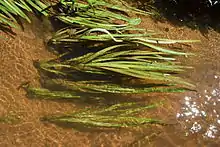Vallisneria americana
Vallisneria americana, commonly called wild celery, water-celery, tape grass, or eelgrass,[1] is a plant in the family Hydrocharitaceae, the "tape-grasses". V. americana is a fresh water species that can tolerate salt, living in salinities varying from fresh water (0 parts per thousand) to 18 parts per thousand, although the limit to the salt tolerance is unclear, and is generally dependent on the duration and intensity of the plants’ exposure to the saline water.[2][3][4] V. americana is a deep rooted plant with leaves, approximately one inch wide, with the ability to rise two or more meters above the clustered base of the plant.[5][6] Contrary to the implications of one of its common names, wild celery bears little to no resemblance to the celery used as a vegetable. V. americana grows under water and is consumed by various animals, including the canvasback. The plants themselves are long, limp, flat, and have a green mid-ridge.
| Vallisneria americana | |
|---|---|
 | |
| Scientific classification | |
| Kingdom: | Plantae |
| Clade: | Tracheophytes |
| Clade: | Angiosperms |
| Clade: | Monocots |
| Order: | Alismatales |
| Family: | Hydrocharitaceae |
| Genus: | Vallisneria |
| Species: | V. americana |
| Binomial name | |
| Vallisneria americana | |
Despite its name, it is not restricted to the Americas. It occurs naturally in Iraq, China, Japan, Korea, India, Papua New Guinea, the Philippines, Australia, Canada, the United States, Mexico, Guatemala, Honduras, Cuba, the Dominican Republic, Haiti and Venezuela.[1] It is found primarily in eastern North America, occurring west from Nova Scotia to South Dakota and South to the Gulf of Mexico. It has also been reported in the western states of Washington, Nebraska, New Mexico and Arizona.[5]
V. americana is cultivated for the aquarium trade, where it is a sold as a background plant.[7]
Habitat and importance
Like many seagrass ecosystems, V. americana beds provide a rich abundance of prey as food for other species, and is a refuge for many species, including commercial, recreational, endangered and invasive organisms, and also acts as a nursery for fishery species.[3][8] Beds of V. americana, especially in Louisiana, have been known to be homes to many crustacean, gastropods, invertebrates and fish, and have been known to be grazed on by West Indian Manatees.[2][8][9] The beds of V. americana are great at stabilizing sediment and shorelines, facilitating detrital food webs, and improving water quality by filtering the surrounding water.[2][3][4][9]
Factors for growth
The salinity tolerance of V. americana has been up to debate, and has been topic of many scientific research and experiments. It has been suggested that the difference between the collected data sets is due to the varying duration of the experiments and the different methodology used in each experiment.[3] The highest tolerance range is generally noted to be anywhere from ten parts per thousand to twenty parts per thousand.[2][3][4] Many experiments have shown that the general trend of growth is that as the salinity of the water goes up, the growth of the plant decreases, but the roots of the plants are known to show greater tolerance to salinity than the shoots do.[3]
Reproduction
V. americana generally maintains its population by clonal reproduction through the use of runners, but they are also capable of reproducing through the use of seeds.[5][10] Salinity seems to affect the germination process in the same way it does the growth of the plant.[10]
References
- "Vallisneria americana". Germplasm Resources Information Network (GRIN). Agricultural Research Service (ARS), United States Department of Agriculture (USDA). Retrieved 1 January 2018.
- Doering, P; Chamberlain, R; Donohue, K; Steinman, A (1999). "Effect of salinity on the growth of Vallisneria americana Michx. From the Caloosahatchee estuary, Florida". Quarterly Journal of the Florida Academy of Science. 62 (2): 89–105.
- Boustany, Ronald; Michot, Thomas; Moss, Rebecca (2010). "Effects of salinity and light on biomass and growth of Vallisneria americana from Lower St. Johns River, FL, USA". Wetlands Ecology and Management. 18 (2): 203–217. doi:10.1007/s11273-009-9160-8. S2CID 24446372.
- Lauer, N; Yeager, M; Kahn, A; Dobberfhl, D; Ross, C (2011). "The effects of short term salinity exposure on the sublethal stress respons of Vallisneria americana Michx (Hydrocharitaceae)". Aquatic Botany. 95 (3): 207–213. doi:10.1016/j.aquabot.2011.06.002.
- Korschgen, Carl; Green, William (1988). American Wildcelery (Vallisneria americana):Ecological Considerations for Restoration (19 ed.). La Crosse, Wisconsin: Fish and Wildlife Technical Report. pp. 1–24.
- Wigand, Cathleen; Wehr, John; Limburg, Karin; Gorham, Bernadette; Longergan, Sean; Findlay, Stuart (2000). "Effects of Vallisneria americana (L.) on community structure and ecosystem function in lake mesocosms". Hydrobiologia. 418: 137–146. doi:10.1023/a:1003808220424. S2CID 31959546.
- Wilson, Rhonda. "Vallisneria". Tropical Fish Hobbyist. TFH Publications. Retrieved 10 December 2013.
- Rozas, Lawrence; Minello, Thomas (2006). "Nekton Us of Vallisneria americana Michx. (Wild Celery) Beds and Adjacent Habitats in Coastal Louisiana". Estuaries and Coasts. 29 (2): 297–310. doi:10.1007/bf02781998. S2CID 84128307.
- Doering, P.; Chamberlain, R.; McMunigal, J (2001). "Effects of simulated saltwater intrusions on the Growth and Survival of Wild Celery, Vallisneria americana, from the Caloosahatchee Estuary (South Florida)". Estuaries. 24 (6A): 894–903. doi:10.2307/1353180. JSTOR 1353180. S2CID 84460897.
- Jarvis, Jessie; Moore, Kenneth (2008). "Influence of environmental factors on Vallisneria americana seed germination". Aquatic Botany. 88 (4): 283–294. doi:10.1016/j.aquabot.2007.12.001.
External links
| Wikimedia Commons has media related to Vallisneria americana. |
| Wikispecies has information related to Vallisneria americana. |
- Maryland DNR's Bay Grass ID Key: Wild celery
- Minnesota DNR Aquatic plant information: Wild celery
- USGS NPWRC report: American Wildcelery (Vallisneria americana) -- Ecological Considerations for Restoration
- Flora boreali-Americana 2:220. 1803